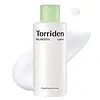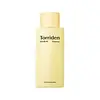What's inside
What's inside
 Key Ingredients
Key Ingredients

 Benefits
Benefits

 Concerns
Concerns

 Ingredients Side-by-side
Ingredients Side-by-side

Water
Skin ConditioningGlycerin
HumectantPentaerythrityl Tetraethylhexanoate
EmollientDipropylene Glycol
HumectantMethylpropanediol
Solvent1,2-Hexanediol
Skin ConditioningCentella Asiatica Extract
CleansingMadecassoside
AntioxidantAsiaticoside
AntioxidantAsiatic Acid
Skin ConditioningMadecassic Acid
Skin ConditioningPanthenol
Skin ConditioningAllantoin
Skin ConditioningSodium Hyaluronate
HumectantTrehalose
HumectantCalendula Officinalis Flower Extract
MaskingChamomilla Recutita Flower Extract
MaskingSwertia Japonica Extract
Skin ConditioningNymphaea Caerulea Flower Extract
Skin ConditioningLactobacillus Ferment
Skin ConditioningVincetoxicum Atratum Extract
Skin ConditioningAlthaea Rosea Flower Extract
Skin ConditioningButylene Glycol
HumectantGlyceryl Stearate
EmollientOctanediol
Cetearyl Alcohol
EmollientJojoba Esters
EmollientPentylene Glycol
Skin ConditioningPolyglyceryl-3 Methylglucose Distearate
EmulsifyingSodium Dilauramidoglutamide Lysine
HumectantHydroxyethyl Acrylate/Sodium Acryloyldimethyl Taurate Copolymer
Emulsion StabilisingSorbitan Sesquioleate
EmulsifyingTromethamine
BufferingSilica
AbrasiveTocopherol
AntioxidantCaprylyl Glycol
EmollientDipotassium Glycyrrhizate
HumectantCitric Acid
BufferingCarbomer
Emulsion StabilisingEthylhexylglycerin
Skin ConditioningWater, Glycerin, Pentaerythrityl Tetraethylhexanoate, Dipropylene Glycol, Methylpropanediol, 1,2-Hexanediol, Centella Asiatica Extract, Madecassoside, Asiaticoside, Asiatic Acid, Madecassic Acid, Panthenol, Allantoin, Sodium Hyaluronate, Trehalose, Calendula Officinalis Flower Extract, Chamomilla Recutita Flower Extract, Swertia Japonica Extract, Nymphaea Caerulea Flower Extract, Lactobacillus Ferment, Vincetoxicum Atratum Extract, Althaea Rosea Flower Extract, Butylene Glycol, Glyceryl Stearate, Octanediol, Cetearyl Alcohol, Jojoba Esters, Pentylene Glycol, Polyglyceryl-3 Methylglucose Distearate, Sodium Dilauramidoglutamide Lysine, Hydroxyethyl Acrylate/Sodium Acryloyldimethyl Taurate Copolymer, Sorbitan Sesquioleate, Tromethamine, Silica, Tocopherol, Caprylyl Glycol, Dipotassium Glycyrrhizate, Citric Acid, Carbomer, Ethylhexylglycerin
Water
Skin ConditioningGlycerin
HumectantButylene Glycol
Humectant1,2-Hexanediol
Skin ConditioningCaprylic/Capric Triglyceride
MaskingPanthenol
Skin ConditioningCeramide NP
Skin ConditioningCeramide Ns
Skin ConditioningCeramide As
Skin ConditioningCeramide EOP
Skin ConditioningCeramide AP
Skin ConditioningChamomilla Recutita Leaf Extract
MaskingCamellia Sinensis Leaf Extract
AntimicrobialThymus Vulgaris Extract
PerfumingMentha Suaveolens Leaf Extract
AstringentAllantoin
Skin ConditioningSodium Hyaluronate
HumectantTrehalose
HumectantSucrose
HumectantCholesterol
EmollientGlycereth-26
HumectantC14-22 Alcohols
Emulsion StabilisingC12-20 Alkyl Glucoside
EmulsifyingPvm/Ma Copolymer
Emulsion StabilisingAcrylates/C10-30 Alkyl Acrylate Crosspolymer
Emulsion StabilisingGlyceryl Acrylate/Acrylic Acid Copolymer
HumectantHydrogenated Lecithin
EmulsifyingTromethamine
BufferingTocopherol
AntioxidantCarthamus Tinctorius Flower Extract
Skin ConditioningAdansonia Digitata Seed Oil
EmollientXanthan Gum
EmulsifyingStearic Acid
CleansingDisodium EDTA
Ethylhexylglycerin
Skin ConditioningWater, Glycerin, Butylene Glycol, 1,2-Hexanediol, Caprylic/Capric Triglyceride, Panthenol, Ceramide NP, Ceramide Ns, Ceramide As, Ceramide EOP, Ceramide AP, Chamomilla Recutita Leaf Extract, Camellia Sinensis Leaf Extract, Thymus Vulgaris Extract, Mentha Suaveolens Leaf Extract, Allantoin, Sodium Hyaluronate, Trehalose, Sucrose, Cholesterol, Glycereth-26, C14-22 Alcohols, C12-20 Alkyl Glucoside, Pvm/Ma Copolymer, Acrylates/C10-30 Alkyl Acrylate Crosspolymer, Glyceryl Acrylate/Acrylic Acid Copolymer, Hydrogenated Lecithin, Tromethamine, Tocopherol, Carthamus Tinctorius Flower Extract, Adansonia Digitata Seed Oil, Xanthan Gum, Stearic Acid, Disodium EDTA, Ethylhexylglycerin
 Reviews
Reviews

Ingredients Explained
These ingredients are found in both products.
Ingredients higher up in an ingredient list are typically present in a larger amount.
1,2-Hexanediol is a synthetic liquid and another multi-functional powerhouse.
It is a:
- Humectant, drawing moisture into the skin
- Emollient, helping to soften skin
- Solvent, dispersing and stabilizing formulas
- Preservative booster, enhancing the antimicrobial activity of other preservatives
Allantoin is a soothing ingredient known for its protective and moisturizingg properties. Because of this, it is often added to products with strong active ingredients.
Studies show higher concentrations of this ingredient can promote wound healing.
Though it can be derived from the comfrey plant, allantoin is produced synthetically for cosmetic products to ensure purity.
Learn more about AllantoinButylene Glycol (or BG) is used within cosmetic products for a few different reasons:
Overall, Butylene Glycol is a safe and well-rounded ingredient that works well with other ingredients.
Though this ingredient works well with most skin types, some people with sensitive skin may experience a reaction such as allergic rashes, closed comedones, or itchiness.
Learn more about Butylene GlycolEthylhexylglycerin (we can't pronounce this either) is commonly used as a preservative and skin softener. It is derived from glyceryl.
You might see Ethylhexylglycerin often paired with other preservatives such as phenoxyethanol. Ethylhexylglycerin has been found to increase the effectiveness of these other preservatives.
Glycerin is already naturally found in your skin. It helps moisturize and protect your skin.
A study from 2016 found glycerin to be more effective as a humectant than AHAs and hyaluronic acid.
As a humectant, it helps the skin stay hydrated by pulling moisture to your skin. The low molecular weight of glycerin allows it to pull moisture into the deeper layers of your skin.
Hydrated skin improves your skin barrier; Your skin barrier helps protect against irritants and bacteria.
Glycerin has also been found to have antimicrobial and antiviral properties. Due to these properties, glycerin is often used in wound and burn treatments.
In cosmetics, glycerin is usually derived from plants such as soybean or palm. However, it can also be sourced from animals, such as tallow or animal fat.
This ingredient is organic, colorless, odorless, and non-toxic.
Glycerin is the name for this ingredient in American English. British English uses Glycerol/Glycerine.
Learn more about GlycerinPanthenol is a common ingredient that helps hydrate and soothe the skin. It is found naturally in our skin and hair.
There are two forms of panthenol: D and L.
D-panthenol is also known as dexpanthenol. Most cosmetics use dexpanthenol or a mixture of D and L-panthenol.
Panthenol is famous due to its ability to go deeper into the skin's layers. Using this ingredient has numerous pros (and no cons):
Like hyaluronic acid, panthenol is a humectant. Humectants are able to bind and hold large amounts of water to keep skin hydrated.
This ingredient works well for wound healing. It works by increasing tissue in the wound and helps close open wounds.
Once oxidized, panthenol converts to pantothenic acid. Panthothenic acid is found in all living cells.
This ingredient is also referred to as pro-vitamin B5.
Learn more about PanthenolSodium Hyaluronate is hyaluronic acid's salt form. It is commonly derived from the sodium salt of hyaluronic acid.
Like hyaluronic acid, it is great at holding water and acts as a humectant. This makes it a great skin hydrating ingredient.
Sodium Hyaluronate is naturally occurring in our bodies and is mostly found in eye fluid and joints.
These are some other common types of Hyaluronic Acid:
Learn more about Sodium HyaluronateTocopherol (also known as Vitamin E) is a common antioxidant used to help protect the skin from free-radicals and strengthen the skin barrier. It's also fat soluble - this means our skin is great at absorbing it.
Vitamin E also helps keep your natural skin lipids healthy. Your lipid skin barrier naturally consists of lipids, ceramides, and fatty acids. Vitamin E offers extra protection for your skin’s lipid barrier, keeping your skin healthy and nourished.
Another benefit is a bit of UV protection. Vitamin E helps reduce the damage caused by UVB rays. (It should not replace your sunscreen). Combining it with Vitamin C can decrease sunburned cells and hyperpigmentation after UV exposure.
You might have noticed Vitamin E + C often paired together. This is because it is great at stabilizing Vitamin C. Using the two together helps increase the effectiveness of both ingredients.
There are often claims that Vitamin E can reduce/prevent scarring, but these claims haven't been confirmed by scientific research.
Learn more about TocopherolTrehalose is a disaccharide made of two glucose molecules (glucose is sugar!). Trehalose is used to help moisturize skin. It also has antioxidant properties.
As a humectant, trehalose helps draw moisture from the air to your skin. This helps keep your skin hydrated.
Due to its antioxidant properties, trehalose may help with signs of aging. Antioxidants help fight free-radical molecules, unstable molecules that may damage your skin.
In medicine, trehalose and hyaluronic acid are used to help treat dry eyes.
Some animals, plants, and bacteria create trehalose as a source of energy to survive freeze or lack of water.
Learn more about TrehaloseTromethamine helps balance the pH and improve the texture of a product. It is synthetically created.
As an emulsifier, Tromethamine prevents oil and water ingredients from separating. This helps stabilize the product and elongate a product's shelf life. Tromethamine also makes a product thicker.
Tromethamine helps balance the pH level of a product. Normal pH level of skin is slightly acidic (~4.75-5.5). The acidity of our skin is maintained by our glands and skin biome. Being slightly acidic allows our skin to create an "acid mantle". This acid mantle is a thin barrier that protects our skin from bacteria and contaminants.
Oral Tromethanmine is an anti-inflammatory drug but plays the role of masking, adding fragrance, and/or balancing pH in skincare.
1,3-Propanediol, 2-amino-2-(hydroxymethyl)-
Learn more about TromethamineWater. It's the most common cosmetic ingredient of all. You'll usually see it at the top of ingredient lists, meaning that it makes up the largest part of the product.
So why is it so popular? Water most often acts as a solvent - this means that it helps dissolve other ingredients into the formulation.
You'll also recognize water as that liquid we all need to stay alive. If you see this, drink a glass of water. Stay hydrated!
Learn more about Water